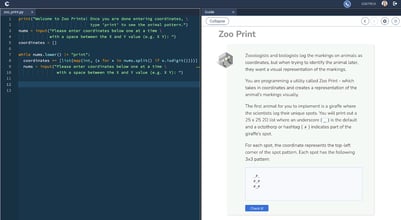We’re pleased to announce that Codio now offers support for Splice, an open protocol that makes assessments more flexible and extensible than ever. Splice wasn’t created by Codio—it’s an open standard that can handle just about any kind of assessment you want to run, from coding exercises to custom simulations. By integrating Splice into Codio, we’re aiming to give instructors the freedom to develop and deliver a wider range of assignments and collect results in a consistent, reliable way.
Why Splice Matters
Splice offers a standardized method for different assessment tools and platforms to exchange information. Instead of each assignment type needing its own specialized setup, Splice provides a common language that communicates everything from submission data to grading outcomes. As an instructor, you can plug in various assessment types—like coding tasks, quizzes, or interactive labs—so long as they speak the Splice protocol. This makes it easier to incorporate external or specialized tools without reinventing the wheel each time.
With Codio’s new Splice support, you can keep your workflow simple even as you diversify your assignment offerings. That means less time spent wrestling with compatibility issues and more time focusing on creating meaningful learning experiences.
Getting Started with Splice in Codio
If you’re already familiar with Splice, you’ll find it straightforward to integrate your custom assessments into Codio. With Splice support you’ll be able to:
- Embed a wide variety of assessment formats directly into your Codio courses.
- Track submissions and results through Codio’s existing grading and analytics features.
- Simplify your assignment pipeline by using a single, open protocol to handle assessment data.
If you’re new to Splice, don’t worry. Our team is here to help you take advantage of this versatile framework so you can explore new ideas in your classroom.

Other Recent Updates: Starter Pointers, Auto-Save, and More
While Splice is the headline addition, we’ve also introduced a few other features to streamline course creation and administration:
- Coming Soon: Blueprints.
Creating new assignments can be time-consuming, especially if you often reuse the same core materials. With blueprints, you can build a ready-made page configuration—complete with instructions, placeholders, layouts, or example code—that you can instantly deploy whenever you spin up a new assignment. This ensures consistency across multiple sections or courses without all the repetitive setup work. - Released: Jupyter Notebook Auto-Save.
We know that losing unsaved work is frustrating for both students and instructors. That’s why our Jupyter Notebooks now automatically save whenever a student clicks Mark as Complete. If you use Codio’s certified Jupyter Notebook stacks, this feature is already available. If you maintain your own custom Jupyter stacks, simply install the Jupyter extension from the “install software” menu and create a new stack version to enable this functionality.
Looking Ahead
Our adoption of the open Splice protocol is a significant step toward expanding the ways you can teach and assess in Codio. Whether you want to incorporate external assessment tools or build your own interactive experiments, Splice helps streamline the process. We hope you’ll find this new functionality valuable as you continue designing creative, engaging activities for your learners.
If you have questions about getting started with Splice or want more details on any of the other recent enhancements, feel free to reach out to our support team. We’re always eager to help you make the most of Codio’s evolving toolkit—and we can’t wait to see how you put Splice to work in your courses.



